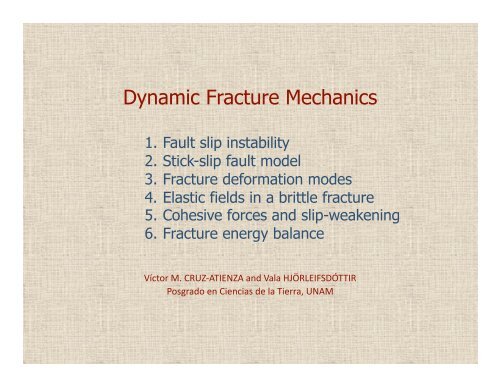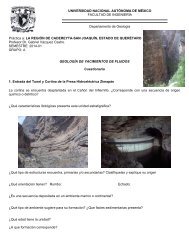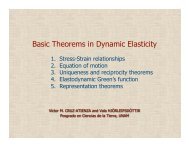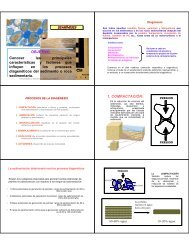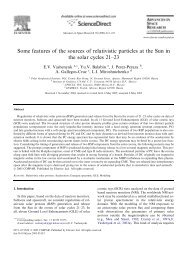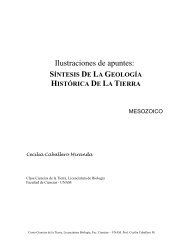You also want an ePaper? Increase the reach of your titles
YUMPU automatically turns print PDFs into web optimized ePapers that Google loves.
Macroscopic Fault <strong>Mechanics</strong>From observations of the 1906 San Franciscoearthquake, Henry F. Reid postulated the elasticrebound theory as the mean to produceearthquakes. An earthquake is the sudden releaseof previously stored elastic stress (i.e. and strain).Coulomb (1773) introduced a simple theory forrocks failure, so that the rock strength (τ) dependson three parameters: 1) cohesion, c, 2) coefficientof internal friction, µ i , and 3) the normal traction, σ n ,on the plane of failure:If rupture happens in a preexisting fault, the fault strength only depends onthe normal traction and µ s , the coefficient of friction, which doesn’t have thesame value µ i , required for failure of unfaulted rocks. We thus have thefollowing relationship, known as Amonton’s second law (1699):
Macroscopic Fault <strong>Mechanics</strong>From the slip instability condition we see that the fault strength evolutionduring an earthquake is critical to either promote or prevent rupturepropagation.Amonton’s second law tells us that the fault strength is proportional to µ, thecoefficient of friction. Assuming constant the fault normal traction, then ruptureonly depends on the time evolution of µ (i.e. the fault friction).Fault friction coefficient is a function of many different physical processestaking place during rupture as temperature, slip rate, slip history and somestate variables varying with time, as we shall see.Let us first study the elasticfields produced by afaulting process in thevicinity of the rupture front.Any faulting mechanismmay be thought as a linearcombination of threefundamental modes ofdeformation:Opening In-plane Anti-plane
Now consider a slip function S thatis 0 for x’ > 0, and given by thelogarithm of |-x’| as show in thefigure for x’ < 0. The shear stressfiled outside the crack is (Aki andRichards, 2002):Microscopic Fault <strong>Dynamic</strong>sStress and slip rate functions satisfyingthis equation in the z = 0 plane arewhere Φ is a constant whichdepends on µ, v r , and α (if i = x)or β (if i = y). This means that thestress field is equal to the Hilberttransform of the slip rate, timesa constant. Thus both fields havethe same shape but with phaseshifted of π/2.where functions K m and A m are,respectively, the stress intensity factorand a constant, both depending on therupture mode m (Aki and Richards, 2002,eqs. 11.6 and 11.7)
Microscopic Fault <strong>Dynamic</strong>sTherefore, the slip rateand shear stress have theform shown in the figure,both of them with asingularity at the crack tip.Stress and slip rate functions for a moving crack with logarithmic slipdistributionwhere functions K m and A m are, respectively, the stress intensity factor and aconstant, both depending of the rupture mode m (Aki and Richards, 2002,eqs. 11.6 and 11.7)
Unidirectional Anti-Plane Moving CrackConsider now a unilateral anti-planerupture (mode III) propagation withvelocity v r and fault length of 2a. Thefault is loaded before rupture with anhomogeneous shear stress τ 0 . Duringpropagation an instantaneous andconstant stress drop Δτ = τ 0 – τ s takesplace in the crack tip, where τ s is thedynamic stress (Freund, 1979). Thus,the shear stress ahead the crack tipand the slip rate within the crack arerespectively given by (Kanamori, 1994):Since seismological observations giveaccess to average source information,by integrating the slip rate over the faultwe get particle velocity and stress drop:
Unidirectional Anti-Plane Moving CrackAs far as the finite fault effects don’tplay a relevant role (e.g. diffractedstopping phases), particle velocity inthe near field and stress drop in amoving crack with constant velocity arein accordance with prediction by Brune(1970) for his penny-shapedinstantaneous source model by a factorof 0.5, which is within uncertainties inseismological interpretation.Penny-shaped Brune’s model
Cohesive Forces over the <strong>Fracture</strong>The preceding analysis assumes linear response all over the medium,including the crack-tip vicinity. However, there is no physical material capableto admit infinite stresses or velocities.Barenblatt (1959) has introduced to concept of cohesive forces in the cracksurface. These forces make both the slip rate and the stress concentrationahead the crack tip to be continuous functions (i.e. singularities disappear)Ida (1972) and then Palmer and Rice (1973)give a physical sense to Barenblatt’s cohesiveforces showing that they represent an opposingresistance to dislocation, an energy dissipativeprocess throughout work done over the cracksurface against those forces.Ida (1972) introduced the concept of “slipweakening”,so that the fracture resistance ina given point is a function of the displacementdiscontinuity D. Different laws for thecohesive force σ were tested, as shown in thefigure:
Cohesive Forces over the <strong>Fracture</strong>The associated displacementdiscontinuities and shearstresses to the above cohesiveforces are shown in bothfigures.<strong>Fracture</strong> displacement discontinuitiesShear tractions inside and outside the fractureNotice the influence of the cohesiveforces on both stresses and and slipfunctions inside the crack. Forsmoothly varying cohesive forces inspace, the shear traction becomescontinuous along the plane wherethe crack is located.
Slip-Weakening FrictionAssuming a linear dependence of theforce with slip S (see figure):Cohesive force as a function of slipThere exists a cohesive zone behind thecrack tip where friction drops to its dynamiclevel
<strong>Fracture</strong> Cohesive ZoneAssuming a linear dependence of theforce with slip S (see figure), Ida (1972)showed that the length of the cohesivezone may be approximated as:Cohesive force as a function of slipwhereAndrews (2004) showed that such azone suffers a contraction with rupturepropagation distance L so thatDay et al. (2005), from energy balanceconsideration, showed that suchLorentz contraction depends on thefracture mode and rupture velocity.
<strong>Fracture</strong> Energy BalanceThe total energy change in the medium dueto a dislocation is given by the Volterrarelationship:From the principle of energy conservation,the energy partition at the rupture frontshould satisfywhere E h is the heat, E k the kinetic energy,E u the elastic energy, E γ (or G) the fractureenergy and E m the mechanical energy(Husseini, 1977).Both members of this equation representthe available energy to move the crackEach term is given as follows:


